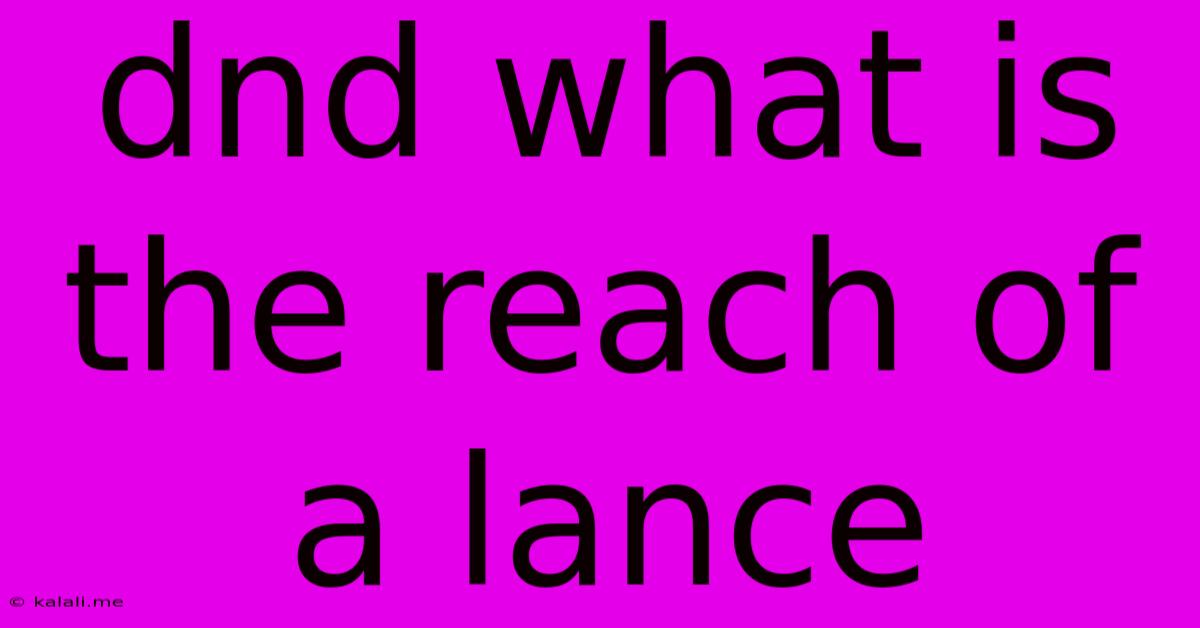Dnd What Is The Reach Of A Lance
Kalali
Jun 10, 2025 · 3 min read

Table of Contents
The Reach of a Lance in Dungeons & Dragons: A Comprehensive Guide
Understanding weapon reach in Dungeons & Dragons (D&D) 5th Edition is crucial for effective combat strategy. This article will delve specifically into the reach of a lance, a weapon often associated with mounted combat and battlefield control. We'll explore its mechanics, strategic implications, and how it compares to other polearms.
What is the Reach of a Lance?
In D&D 5e, a lance has a reach of 10 feet. This means that a creature wielding a lance can attack a target up to 10 feet away without needing to move closer. This significant advantage allows for attacks from a safe distance, especially beneficial for mounted combatants who can maintain a tactical advantage over opponents. This makes the lance a potent weapon in both offensive and defensive scenarios.
Strategic Advantages of the Lance's Reach:
- Maintaining Distance: The extended reach allows characters to strike enemies before they can close in, crucial against melee-focused foes.
- Area Control: A character with a lance can control a larger area, effectively preventing multiple enemies from approaching simultaneously. This is particularly useful in chokepoints or narrow corridors.
- Mounted Combat Superiority: The reach significantly enhances the effectiveness of mounted combat, providing a substantial advantage from horseback. This allows for a swift attack before an enemy can get close enough to threaten the rider.
- Protecting Allies: A lance wielder can act as a shield, protecting more vulnerable allies by keeping enemies at bay.
Lance vs. Other Polearms:
While other polearms like glaives and halberds also offer extended reach, the lance's specialized design and 10-foot reach distinguish it. Glaives and halberds typically have a reach of 10 feet as well, however, their versatility might slightly outweigh the lance in certain situations. For example, a glaive might offer better utility in close-quarters combat due to its more versatile design.
Optimizing Lance Usage:
Maximizing the effectiveness of a lance requires careful consideration:
- Positioning: Choosing the right position is paramount. Take advantage of elevated terrain or chokepoints to enhance your reach advantage.
- Movement: Understanding how movement interacts with the lance's reach can significantly impact combat. Consider using strategic movement to keep enemies within your reach while avoiding their attacks.
- Combat Maneuvers: Combining the lance with other combat maneuvers, such as the Shove action, can further increase its effectiveness.
- Mounted Combat Tactics: If using a mount, coordinate your movements and attacks to maximize your reach advantage and exploit the mount's mobility.
The Importance of Weapon Reach in D&D 5e:
Weapon reach plays a vital role in combat encounters. Understanding the nuances of each weapon's reach is essential for creating effective combat strategies and determining the ideal weapon for a given character build and combat scenario. Choosing a weapon with a greater reach can offer significant advantages in both offense and defense.
Conclusion:
The 10-foot reach of a lance in D&D 5e offers considerable strategic benefits. By understanding its mechanics and utilizing effective tactics, players can leverage this reach to control the battlefield, protect allies, and dominate their opponents in combat. Remember that the optimal weapon choice depends on the character's build, playstyle, and the specific challenges presented in the campaign.
Latest Posts
Latest Posts
-
How Much Does A 12 Pack Of Pop Weigh
Jul 01, 2025
-
How Many Shots In A Half Gallon
Jul 01, 2025
-
Someone Once Told Me The World Was Macaroni
Jul 01, 2025
-
How Long Does It Take To Walk Five Miles
Jul 01, 2025
-
How Many Ounces Is A Pint Of Blueberries
Jul 01, 2025
Related Post
Thank you for visiting our website which covers about Dnd What Is The Reach Of A Lance . We hope the information provided has been useful to you. Feel free to contact us if you have any questions or need further assistance. See you next time and don't miss to bookmark.